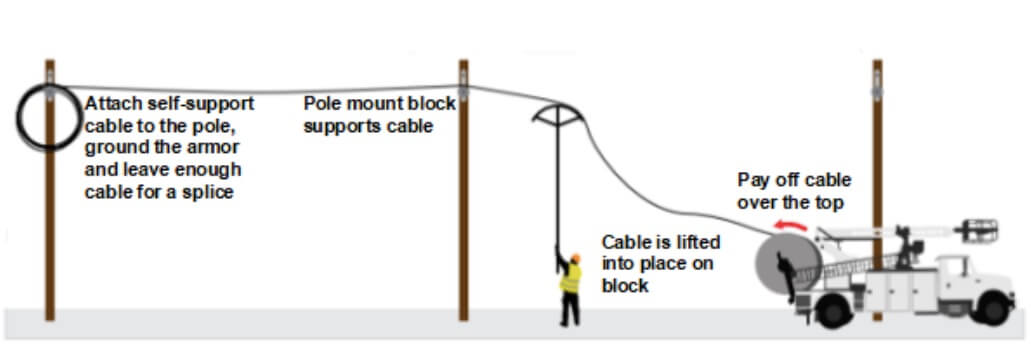Aerial fiber optic cables are specifically designed for installation above ground, typically suspended between utility poles, towers, or other support structures. These cables are widely used for long-distance telecommunications, broadband internet, and utility network applications. Here are some key features and considerations of aerial fiber optic cables:

Construction: Aerial fiber optic cables are designed to withstand the mechanical stresses and environmental conditions encountered in outdoor aerial installations. They typically feature a rugged outer jacket made from materials such as polyethylene (PE) or polyvinyl chloride (PVC) to provide protection against abrasion, weathering, and UV radiation.
Strength Elements: Aerial cables incorporate high-strength components to support their weight over long spans between support structures. These strength elements may include aramid yarns (e.g., Kevlar) or fiberglass rods embedded within the cable core to provide tensile strength and mechanical support.
Optical Fibers: The core of the aerial cable contains one or more optical fibers for transmitting data signals. These fibers are protected by buffer tubes or loose buffer designs to provide mechanical protection against bending, twisting, and other environmental stresses. The number of fibers can vary depending on the specific application and capacity requirements.
Water-Blocking and Moisture Resistance: Aerial cables are designed to resist moisture ingress and maintain signal integrity in outdoor environments. They often incorporate water-blocking materials such as gel-filled buffer tubes, water-swellable tapes, or moisture-resistant coatings to prevent water penetration and minimize the risk of signal degradation.
Installation Features: Aerial fiber optic cables are designed for ease of installation and attachment to support structures. They may include features such as pre-installed pulling eyes, messenger wires, or lashing strands to facilitate aerial installation and ensure proper tensioning between poles or towers.
Environmental Considerations: Aerial cables must withstand a wide range of environmental conditions, including temperature fluctuations, wind loading, ice buildup, and exposure to sunlight. The cable design and materials are selected to provide reliable performance and durability in diverse climates and geographical regions.
Regulatory Compliance: Aerial fiber optic cables must comply with applicable industry standards and regulations governing aerial installations, including safety codes, clearance requirements, and environmental impact assessments. Compliance with these standards ensures the safe and reliable operation of the cable network.
Overall, aerial fiber optic cables play a crucial role in providing high-speed telecommunications and broadband connectivity over long distances, enabling the efficient transmission of data, voice, and video signals in outdoor environments.

Aerial cable installation hardware refers to the various components and accessories used to support, secure, and maintain fiber optic or other cables during aerial installations. These installations typically involve suspending cables between utility poles, towers, or other structures. Here are some common types of aerial cable installation hardware:
Suspension Hardware: Suspension hardware is used to attach the cable to support structures, such as utility poles or towers. This hardware typically includes:
Suspension clamps: These clamps secure the cable to the support structure and provide mechanical support.
Pole brackets: Brackets are used to attach the suspension clamps to the utility poles or towers.
Pole bands: Bands are wrapped around the pole to provide additional support for the suspension hardware.
Dead-End Hardware: Dead-end hardware is used to terminate the cable at the ends of the aerial span. This hardware prevents the cable from slipping or sagging and provides strain relief. Common dead-end hardware includes:
Dead-end clamps: These clamps securely anchor the cable to the support structure.
Guy wire attachments: Guy wires are used to provide additional support and tensioning for the cable, especially in high-wind areas or long spans.
Cable Support Accessories: Various accessories are used to support and protect the cable during installation and operation. These may include:
Cable grips: Grips are used to securely hold the cable during installation and provide strain relief.
Cable brackets: Brackets are attached to the support structure to guide and route the cable along its aerial path.
Cable guards: Guards protect the cable from abrasion and damage caused by contact with other cables or objects.
Lashing Hardware: Lashing hardware is used to secure the cable to the support structure and maintain proper tensioning. This hardware includes:

Lashing wire: Wire is wrapped around the cable and support structure to secure the cable in place.
Lashing clamps: Clamps are used to hold the lashing wire in place and maintain tension.
Weatherproofing Materials: Weatherproofing materials are used to protect the cable and installation hardware from moisture, UV radiation, and other environmental hazards. These materials may include:
Cable closures: Closures are used to seal the ends of the cable and prevent water ingress.
Weatherproofing tape: Tape is applied to cable joints and connections to provide moisture resistance.
Protective coatings: Coatings are applied to hardware components to provide corrosion resistance and UV protection.
Overall, aerial cable installation hardware plays a crucial role in ensuring the safe and reliable installation of fiber optic and other cables in outdoor environments, providing mechanical support, strain relief, and environmental protection.
04-24
202404-23
202404-23
202404-08
202404-07
202403-26
202403-26
202403-18
202403-18
202403-13
2024
